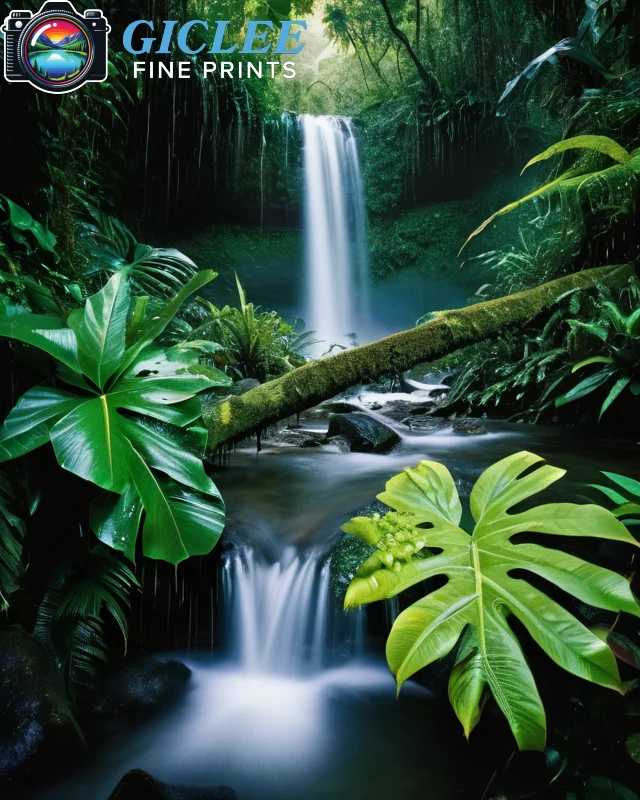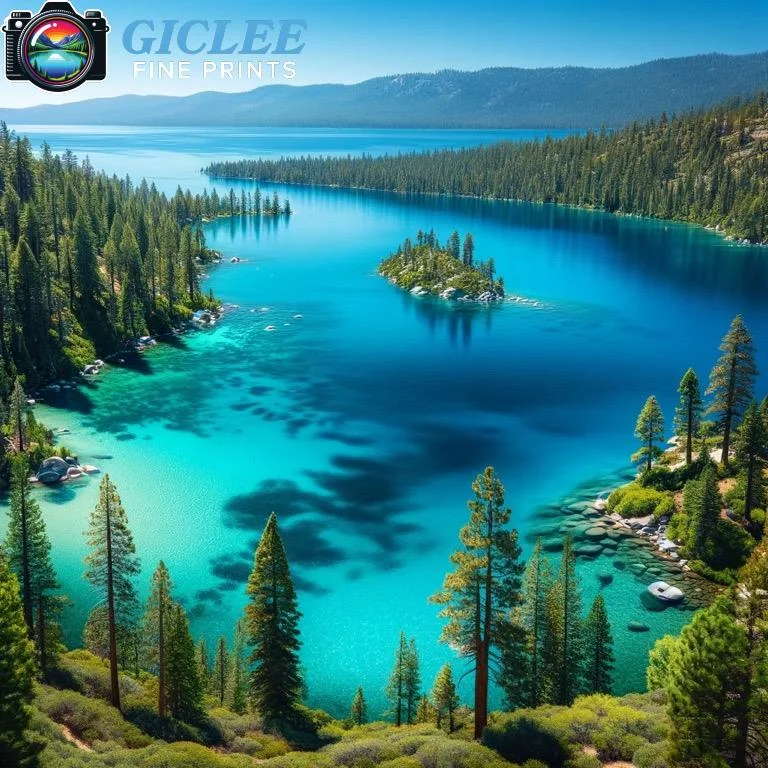
Selecting the right paper type is crucial to achieving the look, feel, and longevity you desire for your prints. The texture, finish, and weight of the paper all influence how the colors and details appear, as well as how durable the print will be over time. At Giclee Fine Prints, we offer a range of high-quality paper options to help you showcase your artwork or photography in the best possible way.
Fine Art Paper for a Classic, Timeless Look
Fine art paper, also known as archival paper, is designed for longevity and a museum-quality appearance. These papers are often textured and made from high-quality, acid-free materials that ensure your prints will stay vibrant and intact for years.
Key Characteristics:
- Textured Surface: Fine art paper has a subtle texture that adds depth and character to prints, making it ideal for classic or traditional artwork.
- Archival Quality: Acid-free and lignin-free, fine art paper prevents yellowing and degradation, preserving the print for a lifetime.
- Soft, Natural Finish: Available in matte finishes, fine art paper gives images a soft, natural appearance, which is perfect for portrait photography, watercolor reproductions, and delicate artwork.
Best For:
- Fine art reproductions, watercolor paintings, and classic photography that benefit from a timeless, textured look.
Matte Paper for Minimal Glare and Soft Color Tones
Matte paper offers a non-reflective surface, making it a popular choice for framing and displaying prints without the interference of glare. This paper type emphasizes softer colors and tones, making it ideal for portraits and black-and-white photography.
Key Characteristics:
- Non-Reflective Surface: Matte paper eliminates glare, providing an unobstructed view of the print from any angle, even under direct lighting.
- Soft Color Reproduction: Colors on matte paper are generally more muted, adding subtlety and elegance to the artwork.
- Smooth or Lightly Textured: Available in both smooth and lightly textured finishes, matte paper is versatile for different styles.
Best For:
- Portraits, black-and-white photos, and minimalist art where a subtle, glare-free look enhances the image.
Glossy Paper for Vivid Colors and High Contrast
Glossy paper enhances the vibrancy of colors and sharpness of details, giving prints a bold and striking appearance. The glossy finish makes colors pop and creates a high-contrast look, ideal for vibrant photography or digital artwork.
Key Characteristics:
- Reflective Surface: Glossy paper has a shiny surface that enhances color saturation and contrast, making it ideal for vivid and colorful prints.
- Sharp Detail: The smooth, glossy surface allows for high-resolution printing, preserving intricate details and sharpness.
- Enhanced Depth: Glossy paper creates a slight depth, making colors appear richer and more dynamic.
Best For:
- Nature photography, digital art, and vibrant color compositions where high contrast and bold colors are essential.

Luster Paper for a Balanced Finish
Luster paper, sometimes called semi-gloss or satin paper, combines the best qualities of matte and glossy finishes. It provides vibrant colors with minimal glare and a soft sheen that is less reflective than full gloss, offering a professional look that is ideal for a wide range of images.
Key Characteristics:
- Soft Sheen: Luster paper has a subtle shine that enhances colors without the harsh reflection of glossy paper.
- Durable Surface: The semi-gloss coating makes luster paper resistant to fingerprints and smudges, which is beneficial for handling and display.
- Rich Color Saturation: While not as intense as glossy, luster paper offers good color reproduction, making it a versatile option for different styles of photography and art.
Best For:
- Portraits, wedding photography, and landscapes where you want vibrant colors with minimal glare.
Canvas Paper for a Textured, Artistic Feel
Canvas paper mimics the look and feel of canvas fabric, providing a unique texture that is especially suitable for fine art reproductions and paintings. The canvas texture gives prints a tactile, gallery-quality appearance that adds character and depth to the artwork.
Key Characteristics:
- Textured Surface: The canvas-like texture adds dimension, making prints feel more like original paintings.
- Durable: Canvas paper is typically thick and sturdy, giving it a professional quality suited for high-end art prints.
- Versatile for Various Art Styles: Ideal for reproducing traditional media like oil and acrylic paintings, canvas paper also works well for textured photography.
Best For:
- Fine art reproductions, digital art mimicking traditional media, and art prints where texture enhances the visual appeal.
Metallic Paper for Unique, Reflective Prints
Metallic paper has a glossy, iridescent finish that enhances color saturation and gives images a three-dimensional effect. This specialty paper is perfect for eye-catching, high-impact artwork that benefits from added depth and shine.
Key Characteristics:
- Iridescent Finish: Metallic paper reflects light in a way that adds depth and dimension to the print, giving it a unique, luminous quality.
- Enhanced Colors and Contrast: Colors on metallic paper are intensified, making it ideal for bold, vibrant artwork.
- Contemporary Aesthetic: The metallic finish is perfect for modern, high-contrast images that need an extra pop.
Best For:
- Modern art, high-contrast photography, and digital illustrations that benefit from an added shine and reflective quality.

Satin Paper for a Soft Glow and Rich Colors
Satin paper has a slight sheen, similar to luster paper, but with a softer, more subdued effect. It offers rich colors with a gentle glow, making it ideal for prints that need a balance between vibrancy and subtlety.
Key Characteristics:
- Gentle Sheen: Satin paper provides a low-glare finish with a soft glow, enhancing colors without being overly reflective.
- Rich Color Depth: While not as vivid as glossy, satin paper still provides rich colors with a soft finish that adds warmth to the image.
- Smooth Surface: The smooth texture and soft sheen give prints a polished, professional look.
Best For:
- Portraits, nature photography, and art prints that benefit from a gentle, polished finish without too much reflection.
Choosing the Right Paper Weight
Paper weight affects the durability and feel of the print. Heavier paper generally feels more substantial and durable, making it ideal for high-quality prints intended for long-term display or sales.
Common Paper Weights:
- Lightweight (below 150 gsm): Ideal for personal or temporary prints, such as proofs or promotional materials, but not typically used for fine art prints.
- Medium Weight (150-250 gsm): Standard for high-quality prints, providing a balance of durability and flexibility without feeling too heavy.
- Heavyweight (above 250 gsm): Often used for professional prints, gallery displays, and fine art reproductions, as it provides a luxurious feel and excellent durability.
Best For:
- Medium to heavyweight papers for professional, long-lasting prints, especially for high-quality art and photography intended for framing or sale.
Contact Us
Our address is: 3816 Pioneer Trail Ste #3, South Lake Tahoe, CA 96150
Email: Info@gicleefineprints.com
FAQs
Glossy and metallic papers are best for vibrant, color-rich images, as they enhance saturation and contrast, making colors appear vivid and dynamic.
Matte or satin paper works well for black-and-white photography, as it emphasizes soft tones and minimizes glare, giving the print a classic, refined look.
Fine art paper is ideal for archival quality and textured looks, making it great for fine art and photography, but it may not suit images requiring high-gloss finishes or intense vibrancy.


